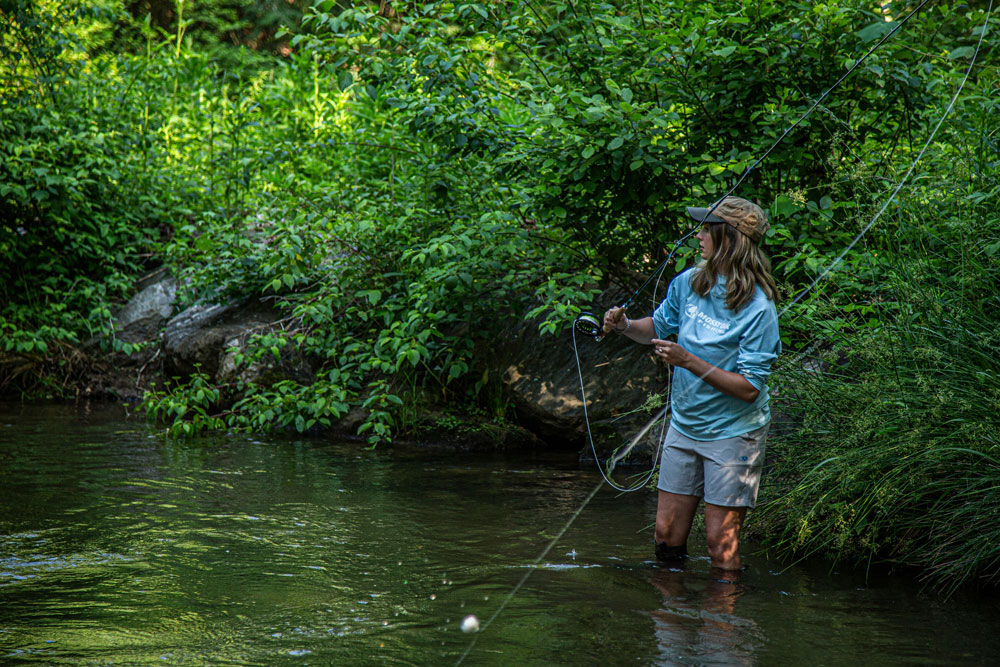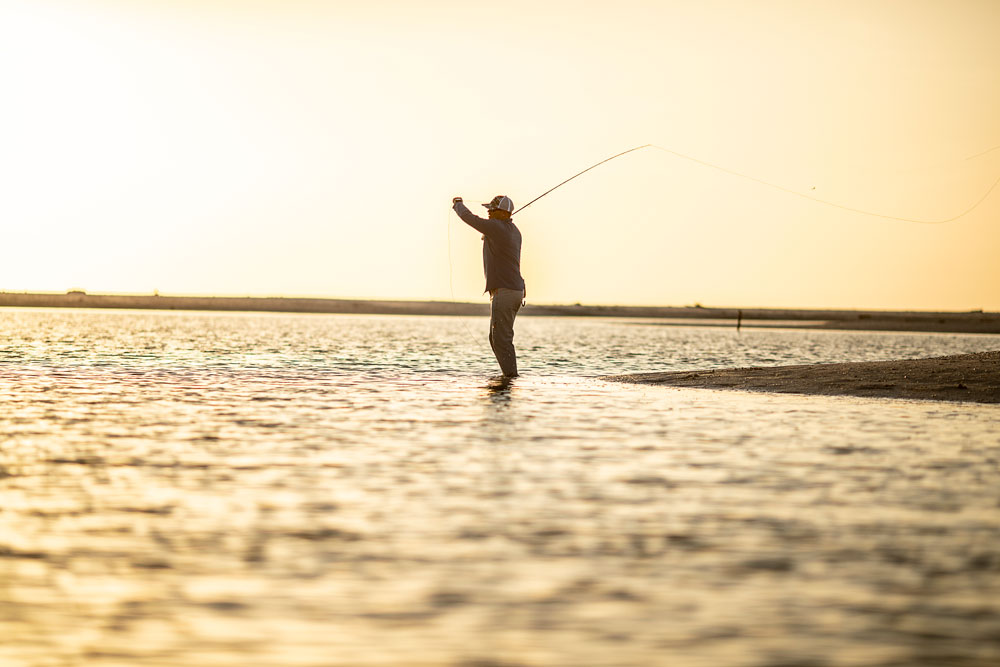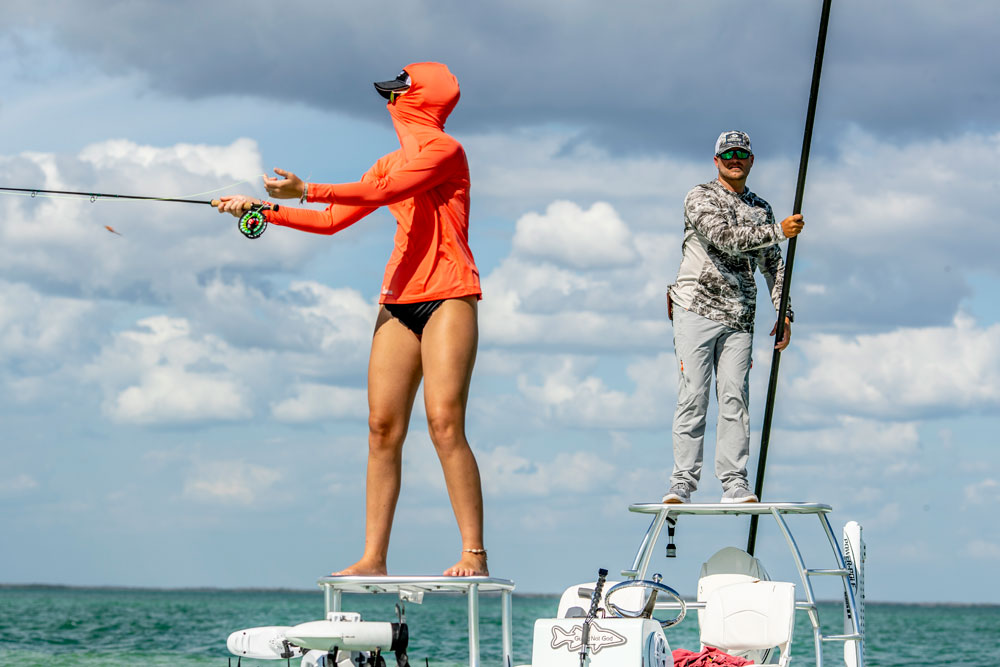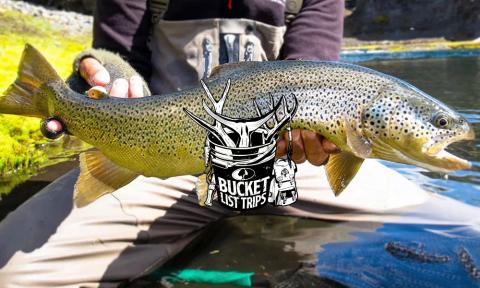One of the things that makes fly fishing distinctive from other types of fishing, like angling or deep sea fishing, is your ability to change your cast to fit the situation best. The ability to adapt to your environment, instead of trying to make your environment adapt to you, makes fly fishing different from other methods.
If you find yourself stuck on a steep embankment with debris, deadfall, trees or anything else behind you, it can be challenging to find the room it takes for a regular backcast. If you don’t have enough space behind you for a long backcast, you can shorten it into a roll cast, which is one of the most crucial techniques in fly fishing.
Before any angler takes on the roll cast, they should have a good grip on the basic backcast. If you’ve mastered the basic backcast, you can move on to this ingenious move. It is a skill that every angler should have when fishing small streams and rivers with a lot of debris or obstacles. Before you hit that river, here are the basic steps to making an accurate roll cast.
Breaking Down a Trout Stream
Fly Casting 101: How to Roll Cast
Beginners are always searching for fly fishing tips to help them catch more fish. They want to know what skill to master next to take their fly fishing game to another level. Seasoned anglers are quick to point out that learning to roll cast is something every beginner should learn to do. Learning to roll cast is one of the best fly fishing tips for beginners. Fly casting can be difficult when there are obstacles at your back, you need to put your dry fly back down quickly or you want to cast subtly. The roll cast is a perfect choice. Roll casts are often used in small streams or while nymph fishing.
A roll cast uses the tension between your fly fishing line and the water surface. This tension propels your fly line forward in a rolling loop until it straightens out and drops onto the water’s surface. This casting technique became popular with the advent of graphite poles, which are more flexible than their predecessors.
There are really just three steps to making an accurate roll cast. Of course, that doesn’t mean that it is all that easy. It takes practice and a lot of patience to become proficient at roll casting. Many anglers prefer to take casting lessons from a pro, but before you go that route, check out the following three steps. They could save you some money.
Step 1: Unfurl Some Fly Line
To learn how to roll cast, start on dry land, preferably on grass, which mimics the tension on the water. Pull out about 20 feet of line in front of you.

One way to do this is to push your rod tip below your reel and let the fishing line puddle at your feet. Then walk backward so the line lies in a straight line. When you’re on the river, the water tension holds the line. When you pull it back, it creates energy in your fly line.
Basics of Casting a Fly Rod
Step 2: Go Through the Motions with Your Fly Rod
Using a clock analogy in which noon would be holding your rod tip straight up and six o’clock would have it pointing straight down, raise your rod-bearing hand parallel to your ear to a one o’clock position — up and slightly behind your shoulder. Your elbow should be canted out slightly.
You have now made a D-loop — a sweeping loop of line that, when seen in profile with your rod, makes the letter “D.” This D-loop contains all the power and loads your rod with energy as you flick your wrist forward. With a flick forward, your line curls out into the air and lands onto your target. This flick is the same motion you use in the overhead movement of a standard forward cast.
It shoots your line out in front of you, unfurling it into the air. The reason for canting your rod out initially is so your line does not swat you in the face on its way past. Your rod tip should be moving forward and be parallel to the line on the water that’s being pulled backward.
One of the most integral parts of making an accurate roll cast is to use a smooth acceleration of power as you flick your rod and pull it to a crisp stop. You should be using just enough power to get the line to pull off the surface and turn over. The fly should drop onto the water’s surface — not puncture it.

Step 3: Mind the Angle of Your Fly Rod
The crucial step in a roll cast is to mind your angles. You need to hold your rod hand on level with your ears and your elbow bent out a little.
If you start at 2 o’clock with your rod high and behind you, you should end the cast with it between 10 and 11 o’clock in front of you. If you drop the tip too low on the release, your line will unfurl on the water’s surface and not in the air, as it’s supposed to.
These three steps will help you learn to make an accurate roll cast. It is a skill every fly fisherman should learn and one they can count on to help them fish small streams. The roll cast is also something that anglers who fish nymphs use all the time. Once you have mastered the roll cast, you have a skill that will open up fly fishing opportunities you otherwise would not have.
How to Roll Cast
Variations on the Roll Cast
To increase your chances of having a successful trip, you’ll need to learn what to wear fly fishing and what kind of rod and reel to use. You’ll need to practice your roll casts multiple times and make some slight tweaks to fine-tune your casting technique to your abilities. Like anything, there is always something out there to test your skills. It usually requires a small tweak or change in your delivery to overcome the challenge. Fly casting is no different. Let's look a little further into variations that can up your roll cast game.
The amount of line roughly translates into how much power you’re using in your roll cast. The longer the line, the larger the D-loop; the larger the D-loop, the more power you have in your cast.
You can add hauls if you would like to put some more power into your line. Haul back on your backcast as it creates a D-loop and again as you flick the line forward. The first haul makes your D-loop more dynamic and powerful, and the second one will add speed to your cast.
You can roll cast from various stances, and an off-shoulder roll cast is an excellent variation for tight spots. It feels a bit awkward at first, but casting from your off-shoulder is a perfect option for shorter shots and inclement weather like a stiff wind.
Instead of drawing the rod up and over your casting shoulder, you need to start it over your non-dominant shoulder and cast it in a diagonal direction across your chest.
Mastering these variations can make life easier when fishing around obstacles on a small stream. There is not a lot of room to maneuver on many small streams, but these places can hold a lot of fish. Challenge yourself to master these variations and put those fish in the kreel.

Fish Like a Pro
Fly fishing is a beautiful and peaceful sport that blends the tranquility of fishing and adds the graceful arabesques of fly casts. Even novice anglers can appreciate the sheer joy of fly fishing. It’s an art form as much as anything and most fly fishermen understand you never stop learning. Once you’ve mastered a primary cast, a roll cast should be next on your skills list.
A roll cast is an excellent option for tight spots or windy days. It takes practice and — like many things — it’s something you need to practice every so often or you will lose what you have learned. By minding your angles, employing a haul and smoothly accelerating, you’ll be roll casting with the best of them in no time. Before your next big fly fishing trip, visit Mossy Oak to get your fishing apparel.






























